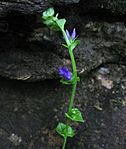Clasping Venus' looking-glass facts for kids
Quick facts for kids Clasping Venus' looking-glass |
|
|---|---|
 |
|
| Scientific classification | |
| Genus: |
Triodanis
|
| Species: |
perfoliata
|
| Synonyms | |
|
|
Triodanis perfoliata, also known as the clasping Venus' looking-glass or clasping bellflower, is a pretty flowering plant. It belongs to the Campanulaceae family, which is also known as the bellflower family. This plant grows every year (it's an annual herb) and is originally from North America and South America, stretching all the way from Canada to Argentina. You can also find it growing in places like China, Korea, and Australia, where it has spread naturally.
What Does It Look Like?
The flowers of the clasping Venus' looking-glass are usually violet-blue. They can be shaped like a wheel or a bell. Each flower has five parts that spread out like petals, and they are perfectly symmetrical, meaning they look the same from all sides.
The leaves are about 1/4 to 1 inch wide. They have edges that look like scallops and are shaped a bit like a shell. The plant itself usually grows to be about 6 to 18 inches tall. It blooms, or flowers, from May all the way through August. After the flowers, the plant makes a small fruit. This fruit is a capsule that holds many tiny seeds.
Traditional Uses by Native Americans
Native American tribes have used the clasping Venus' looking-glass plant for different purposes.
The Cherokee people would prepare a liquid from the root of the plant. They used this to help with an upset stomach, especially after eating too much. They also made a special bath using the roots to help with digestion problems.
The Meskwaki tribe used this plant in their ceremonies. They would prepare it to help cleanse the body. They also smoked parts of the plant during special events.


